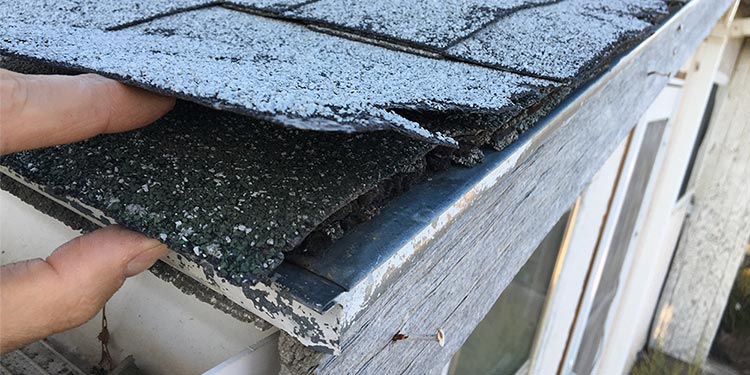It’s time for a new roof, you’re going to do it yourself, and you’re wondering if you really have to remove the old asphalt shingle first. After all, removing your old roof will take some time and effort. It’s going to make a mess. It’s inevitable you loose a nail or more on the ground. Do you really have to remove the old roof? Can’t you just roof over the old shingles?
Quick Answer: No, you shouldn’t roof over existing shingles: it adds extra weight your house isn’t built for, the new shingles don’t lay flat, you’ll have to use longer nails, and it’s just more work later.
Sometimes we’re called out to quote a residential roofing project and we find that someone has roofed over existing shingles. That is, they’ve installed new shingles over old, damaged or worn-out ones. Often when we see this, we learn that it was the homeowner that installed the new shingles over the old ones, and not a roofing company. Most roofing companies know not to do this.

Why You Shouldn’t Roof Over Existing Shingles
Weight
Asphalt shingles are heavy. A bundle weighs between 50 and 80 pounds. The roofing deck (that’s the wooden structure below the shingles) wasn’t designed to support the weight of two layers of roofing shingles. When we are getting ready to reroof a home, we will pile the new shingles onto the existing roof. This is temporary, however. When you install a second layer of roofing shingles, you’re compromising the stability and integrity of your home or structure. You’re putting you and your family at risk.
Lay Flat
Shingles are designed to be installed onto a flat, solid surface, such as your roofing deck, not a flexible, wavy surface like another layer of roofing shingles. Each shingle depends upon a flat surface to function properly. When you install roofing shingles onto an existing layer of shingles, that existing layer is not flat or solid.
Security
Roofing shingles are installed by first nailing one row of shingles to the roofing deck at the bottom of your roof. The nails are meant to go through the shingles and felt, and into the roof deck by at least 3/4″. The second row of shingles covers approximately 2/3 of the first row. The nails go through the first and second layer of shingles and into the roof deck by at least 3/4″. Then a third row of shingles is installed, again, covering 2/3 of the second row. The nails go through this third row, second row, felt, and at least 3/4″ into the roof deck. If you install new shingles over existing shingles, your nails will need to go through two new shingles, plus the two old shingles, so four shingles total. Normal roofing nails aren’t long enough to go through four layers of shingles. As a result, your roof won’t be as solid or secure. Your roof has a great chance of being blown-off by high winds.
The Cover-Up
What if there’s an unseen problem with the first layer of shingles, such as a leak? If you just roof over the problem, you’re not fixing the leak – you’re just covering it up. What’s more, if there’s the slightest bit of mold or algae on the first layer, and you add another layer of shingles on top of that, that mold or algae will spread due to the warm, humid environment you just created for it, and you just shortened the life of your new shingles.
Inspection
When you go to sell your house, the inspector will notice two layers of shingles, and they won’t like it. Neither will the new buyers. You will have to tear it all off, even the newer shingles, and start over. You may as well do it right the first time. If you are within our service area, contact us for a free estimate.
Tear-off and Installation
What’s worse is, with now two layers of shingles to remove, it takes more time to remove the old roof. A lot more time. A skilled roofer can remove 300-400 sf of asphalt shingles in about an hour. But that’s one layer of asphalt shingles. Two layers of shingles serious reduces the speed at which a roof can be removed. It’s also twice the mess.
The Bottom Line
If you’re reroofing yourself, you might be thinking it’ll save you some time now by leaving the old shingles down and install new ones right over top. While this is true, it will only cause you problems later. Do the job right the first time and remove those old, worn-out, or damaged shingles before you install new ones. You’re only putting-off the work of removing that first layer of shingles.
If you are nearby and are in need of Colorado roofing services, contact us now! We install and repair roofs in Greeley, Loveland, Fort Collins, Denver, and surrounding areas.
